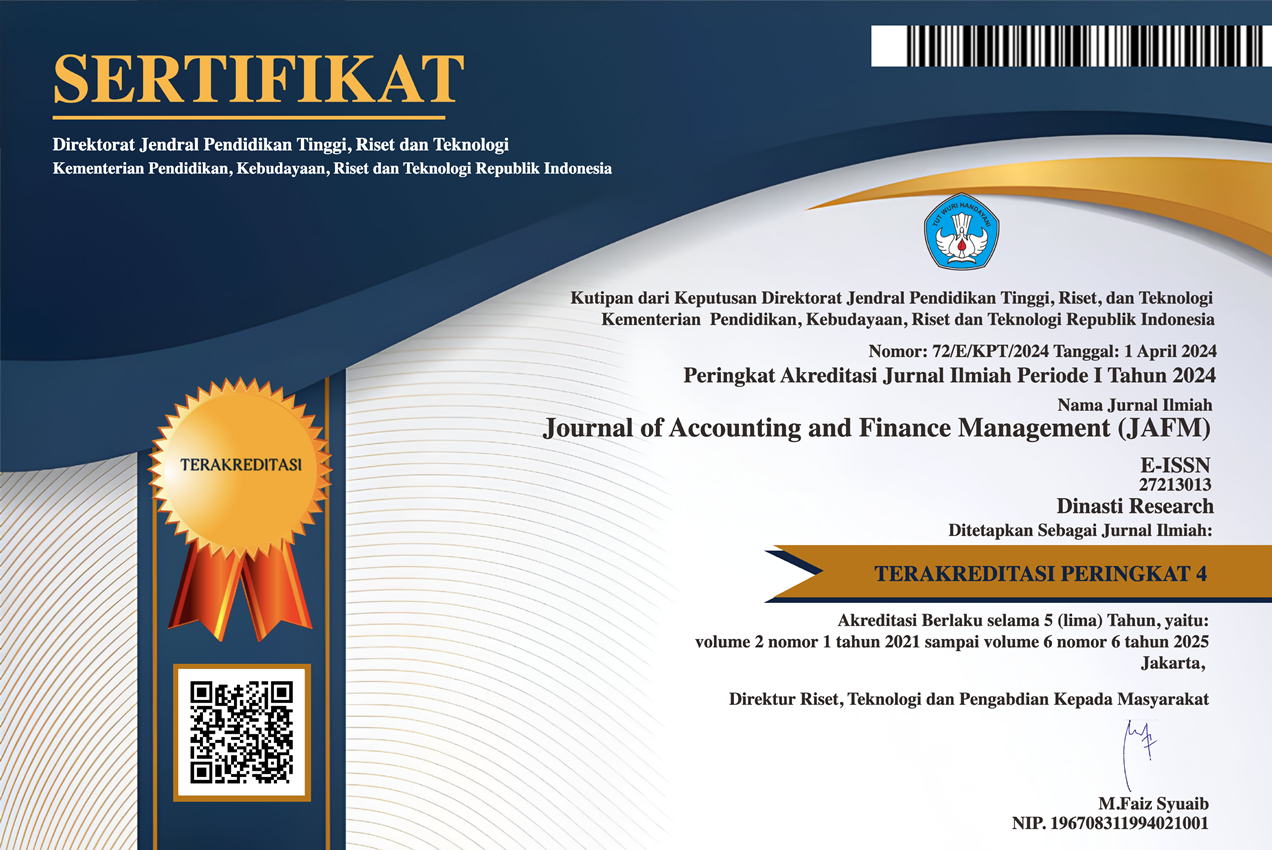Analysis of Cashless Payment Adoption using the Unified Theory of Acceptance and Use of Technology (UTAUT)
DOI:
https://doi.org/10.38035/jafm.v5i3.720Keywords:
perceived usefulnee, perceived ease of use, social influence, facilitating condition, intention of use, adoption, cashless payment, UTAUTAbstract
This study aims to analyze the adoption of cashless payments in West Sumatra using the Unified Theory of Acceptance and Use of Technology (UTAUT) model. The variables studied include Perceived Usefulness, Perceived Ease of Use, Social Influence, Facilitating Conditions, and Lifestyle Compatibility on the Intention to Use and Adoption of Cashless Payments, moderated by gender and level of education. The method used in this research is Structural Equation Modeling (SEM) with SmartPLS 4.0. Data was obtained from questionnaires distributed to 210 respondents in the cities of Padang, Pariaman, Padang Panjang, Bukittinggi, Payakumbuh, and Solok. The results showed that facilitating conditions and compatibility had a significant positive effect on the intention to use cashless payments, while perceived usefulness, ease of use, and social influence had no effect on the intention to use cashless payments. Furthermore, the intention to use cashless payments had a significant positive effect on the adoption of cashless payments. Meanwhile, gender and education level did not have a significant effect on the relationship between the independent variables and the intention to use cashless payments. This study implies that the government needs to improve facilities and technological support for cashless payment users. It also suggests that researchers should consider other variables that may affect the use of cashless payments in future studies.
References
Abdullah, N., Redzuan, F., & Aziah Daud, N. (2020). E-wallet: factors influencing user acceptance towards cashless society in Malaysia among public universities. Indonesian Journal of Electrical Engineering and Computer Science, 20(1), 67. https://doi.org/10.11591/ijeecs.v20.i1.pp67-74
Al, M. D. B. (2023). Kemajuan Teknologi Dan Pola Hidup Manusia Dalam Perspektif Sosial Budaya. : : Jurnal Ilmu Komunikasi, Sosial Dan Humaniora, 1(3). https://doi.org/https://doi.org/10.47861/tuturan.v1i3.272
Bank Indonesia. (2020). Sistem Pembayaran & Pengelolaan Uang Rupiah. Bank Indonesia.
Bank Indonesia. (2023). Elektronifikasi. Bank Indonesia. https://www.bi.go.id/id/fungsi-utama/sistem-pembayaran/ritel/elektronifikasi/default.aspx
Da?tan, ?., & Gürler, C. (2016). Factors Affecting the Adoption of Mobile Payment Systems: An Empirical Analysis. EMAJ: Emerging Markets Journal, 6(1), 17–24. https://doi.org/10.5195/emaj.2016.95
de Blanes Sebastián, M. G., Antonovica, A., & Sarmiento Guede, J. R. (2023). What are the leading factors for using Spanish peer-to-peer mobile payment platform Bizum? The applied analysis of the UTAUT2 model. Technological Forecasting and Social Change, 187, 122235. https://doi.org/10.1016/j.techfore.2022.122235
Dieu, H. T. M., Al Mamun, A., Nguyen, T. L. H., & Naznen, F. (2023). Cashless Vietnam: a study on intention and adoption of cashless payment. Journal of Science and Technology Policy Management. https://doi.org/10.1108/JSTPM-02-2022-0031
Fabris, N. (2019). Cashless Society - The Future of Money or a Utopia? Journal of Central Banking Theory and Practice, 8(1), 53–66. https://doi.org/10.2478/jcbtp-2019-0003
Goh, Q. Z., & Nguyen, L. T. P. (2022). Determining Factors that Influence Consumer Behaviour Intention to Use Cashless Payment in Malaysia (pp. 31–51). https://doi.org/10.2991/978-94-6463-080-0_4
Hair, J. F., Black, W. C., Babin, B. J., Anderson, R. E., & Tatham, R. L. (2019). Multivariate Data Analysis (8th ed.). Cengage Learning.
Hossain, M. A., Imran Hasan, M., Chan, C., & Uddin Ahmed, J. (2017). Predicting User Acceptance and Continuance Behaviour Towards Location-based Services: The Moderating Effect of Facilitating Conditions on Behavioural Intention and Actual Use. In Australasian Journal of Information Systems Hossain (Vol. 21).
Kurniadi, E., Gladisca Hendityasari, G., & Minsani Mariani, D. (2021). Analysis Factors Affecting Lenders Intention In P2p Lending Platform Using Utaut2 Model. In Turkish Journal of Computer and Mathematics Education (Vol. 12, Issue 3).
Mehta, A., Morris, N. P., Swinnerton, B., & Homer, M. (2019). The Influence of Values on E-learning Adoption. Computers & Education, 141, 103617. https://doi.org/10.1016/j.compedu.2019.103617
Munikrishnan, U. T., Mamun, A. Al, Xin, N. K. S., Chian, H. S., & Naznen, F. (2024). Modelling the intention and adoption of cashless payment methods among the young adults in Malaysia. Journal of Science and Technology Policy Management, 15(2), 374–395. https://doi.org/10.1108/JSTPM-04-2022-0077
Rahman, M., Ismail, I., Bahri, S., & Rahman, M. K. (2022). An Empirical Analysis of Cashless Payment Systems for Business Transactions. Journal of Open Innovation: Technology, Market, and Complexity, 8(4), 213. https://doi.org/10.3390/joitmc8040213
Sakib, Md. N., Akter, M., Sahabuddin, M., & Fahlevi, M. (2024). An application of the extended UTAUT model to understand the adoption of cashless transactions: evidence from developing country. Journal of Science and Technology Policy Management. https://doi.org/10.1108/JSTPM-09-2023-0156
Simorangkir, Z. Z., & Afgani, K. F. (2021). The Analysis On Factors Influencing The Use of Mobile Payment System Among Generation Z in Bekasi City. Advanced International Journal of Business, Entrepreneurship and SMEs, 3(9), 334–348. https://doi.org/10.35631/aijbes.39022
Venkatesh, Morris, Davis, & Davis. (2003). User Acceptance of Information Technology: Toward a Unified View. MIS Quarterly, 27(3), 425. https://doi.org/10.2307/30036540
Venkatesh, Thong, & Xu. (2012). Consumer Acceptance and Use of Information Technology: Extending the Unified Theory of Acceptance and Use of Technology. MIS Quarterly, 36(1), 157. https://doi.org/10.2307/41410412
Widiyati, D., & Hasanah, N. (2020). Factor Affecting The Use of E-Money (Study ON E-Money User in City of South Tangerang). ACCOUNTABILITY, 9(1), 36. https://doi.org/10.32400/ja.28881.9.1.2020.36-45
Yang, M., Mamun, A. Al, Mohiuddin, M., Nawi, N. C., & Zainol, N. R. (2021). Cashless Transactions: A Study on Intention and Adoption of e-Wallets. Sustainability, 13(2), 831. https://doi.org/10.3390/su13020831
Downloads
Published
How to Cite
Issue
Section
License
Copyright (c) 2024 Rahma Dinda, Mohamad Fany Alfarisy, Rida Rahim

This work is licensed under a Creative Commons Attribution 4.0 International License.
Authors who publish their manuscripts in this journal agree to the following conditions:
- The copyright on each article belongs to the author(s).
- The author acknowledges that the Journal of Accounting and Finance Management (JAFM) has the right to be the first to publish with a Creative Commons Attribution 4.0 International license (Attribution 4.0 International (CC BY 4.0).
- Authors can submit articles separately, arrange for the non-exclusive distribution of manuscripts that have been published in this journal into other versions (e.g., sent to the author's institutional repository, publication into books, etc.), by acknowledging that the manuscript has been published for the first time in the Journal of Accounting and Finance Management (JAFM).



























